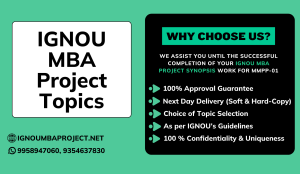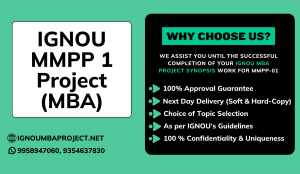The Indira Gandhi National Open University (IGNOU) Master of Science in Computer Science (MSCIS) curriculum relies heavily on the IGNOU MSCIS Project. This project allows students to apply theoretical information learned throughout study to practical, real-world difficulties in computer science. The major goal is to gain a thorough grasp of computer systems, software development, and information technology applications.
The project work often entails conducting research, designing, and implementing a software application, system, or study in a specific area of computer science, such as data analytics, networking, artificial intelligence, or software engineering. Students are required to identify a problem or area for improvement, propose a solution, and carry out the project with the assistance of a faculty supervisor or project guide.
What are the key steps to start planning your IGNOU MSCIS Project efficiently?
Starting your IGNOU MSCIS Project efficiently requires a well-structured approach. Here are the key steps to help you plan your project effectively:
1. Understand the Project Requirements
Before diving into your project, carefully review the project guidelines provided by IGNOU. Make sure you understand:
- Objectives of the project
- Assessment criteria and evaluation procedure
- Submission Guidelines, including Formats and Deadlines
- Any further instructions from your project supervisor or study center
2. Choose a Relevant and Feasible Topic
Select a project topic that:
- Aligns with your computer science interests and professional ambitions.
- Is feasible given the time and resources available to you.
- Addresses a real-world issue or adds to ongoing study in the topic.
- Is detailed enough to manage while remaining wide enough to provide major research opportunities.
- Can be carried out utilizing the skills and knowledge you’ve gained during your training.
3. Conduct Preliminary Research
Start by gathering information related to your chosen topic:
- Performa literature review to learn about current research and technical breakthroughs in your field of interest.
- Identify gaps or possibilities for your initiative to contribute.
- Look for current solutions or studies that can serve as a foundation for your project.
- Make a list of potential tools, technologies, or frameworks that you could utilize.
4. Define the Project Scope and Objectives
Clearly define:
- The issue statement that your project will address.
- The scope of the project, including which aspects you will concentrate on.
- Project objectives and expected results.
- A high-level overview of the deliverables (such as software applications, system designs, and data analysis).
5. Develop a Project Plan and Timeline
Create a timeline with the following milestones:
- Project proposal submission and approval.
- Complete the literature review.
- There are two phases: research and design.
- Implementation and testing phases.
- Report authoring and final submission. Set aside time for each work and guarantee you can meet deadlines properly.
6. Select the Methodology and Tools
Choose the research and development methodology that best fits your project. Some examples include:
- Software development can be done using either Agile or waterfall methodologies.
- Data collecting methods include surveys, experiments, and simulations.
- Choose the tools, programming languages, and frameworks you’ll need for development, testing, and data analysis.
7. Set Clear Milestones and Break Down Tasks
- Break down your project into smaller, more doable activities.
- Set specific timelines for each activity (such as completing the design, development, or testing phases).
- Plan your weekly or monthly targets to guarantee consistent improvement.
8. Meet with Your Supervisor
Regularly consult your project guide or supervisor:
- Discuss your project’s plan, concepts, and technique.
- Get input on your topic, approach, and design.
- Seek clarity on any standards or expectations.
- Set regular check-ins to ensure you stay on target.
9. Plan for Documentation
- Create an outline for your project report from the outset.
- Organize your project’s sections (such as introduction, literature review, methods, findings, and conclusions).
- Maintain detailed technical documentation for the code, system design, and testing phases.
10. Start with a Prototype or Design
If your project involves software development:
- Create a prototype or rudimentary design early on to determine the viability of your strategy.
- Use this prototype to discover any potential issues or adjustments before moving forward with complete development.
11. Plan for Testing and Validation
Consider how you will:
- Evaluate your system or application’s performance, usefulness, and security.
- Validate the results to confirm that your solution is reliable.
- Collect feedback from future users or stakeholders, where applicable.
See this also: Professional Guidance for Your IGNOU MCOM Project Journey
Sample of IGNOU MSCIS Project topics
- A STUDY ON ENHANCING DEFENSE MECHANISM IN WIRELESS SENSOR NETWORKS OF ORGANISATION
- DIGITAL INFORMATION SECURITY MANAGEMENT MODEL FOR UNIVERSITY LIBRARIES
- EFFICIENCY OF THE NODES IN WIRELESS SENSOR NETWORKS TO INCREASE THE SECURITY LEVEL OF ORGANISATION
- AN EMPIRICAL STUDY ON SECURITY THREATS AND ATTACKS ON CLOUD COMPUTING SYSTEMS
- SECURED DATA STORAGE AND RETRIEVAL TECHNIQUES FOR PERFORMANCE ENHANCEMENT IN CLOUD COMPUTING
What are the best research methodologies to apply in a computer science project?
The optimum research approaches for an IGNOU MSCIS Project are determined by the nature of the problem being addressed and the project type. However, numerous popular approaches can be efficiently used:
- Experimental Research: Experimental research is used to test hypotheses and investigate how different variables affect outcomes. It is appropriate for projects that need system development, algorithms, or performance evaluation. To see what happens, try various settings, datasets, or parameters.
- Quantitative Research: Quantitative research is used for data-driven tasks including big data processing, machine learning, and network traffic analysis. To validate your conclusions, you must collect numerical data, which can then be examined statistically.
- Qualitative Research: Qualitative research is useful for UX studies, software usability testing, and human-computer interface projects. It focuses on subjective data and uses interviews, surveys, or user observations to better understand user habits and preferences.
- Case Study: Involves a thorough examination of a single system or problem, which is very useful for software engineering and systems analysis projects.
- Design and Development: A prevalent process in system design or software development projects that focuses on developing and testing prototypes to solve specific technical difficulties.
What is the process for submitting my final MSCIS project report to IGNOU?
The process for submitting your final IGNOU MSCIS Project report involves several steps. Here’s a general overview of the process:
1. Complete the Project Work
Before submission, make sure the following are completed:
- Project objectives and goals are fully addressed.
- Research and development activities are completed, including any coding, experiments, or data collection.
- Testing and validation have been undertaken, and the findings are documented.
- Ensure your project report is well-structured, appropriately written, and complies to the required format.
2. Prepare the Project Report
Your MSCIS project report should be thorough and include:
- Title page with project title, student details, supervisor’s name, and date.
- Abstract summarizing the project in about 150-200 words.
- Acknowledgments section.
- Table of contents for easy navigation.
- Introduction, where you define the problem statement and objectives.
- Literature review on relevant topics.
- Methodology used for the project.
- System design and implementation details (e.g., coding or architectural models).
- Testing and results with analysis and evaluation.
- Conclusion summarizing findings and possible future work.
- References and Appendices.
- Ensure that all references are properly cited according to the prescribed citation style (usually APA or IEEE).
3. Get the Project Proposal Approved (If Required)
- Some projects require proposal approval before work begins. If this applies to your project, ensure that your supervisor has accepted your project proposal.
- This approval might be given at the start of the project or at the end, based on your individual rules.
4. Submit the Project Report to Your Supervisor
Once your report is completed:
- Send a final draft of your project report to your supervisor for evaluation.
- The supervisor will evaluate it and may recommend modifications or enhancements.
- Before moving forward with your final submission, make sure to integrate any feedback from your supervisor.
5. Submit the Report to IGNOU
- The MSCIS project report is finalized and submitted through your study center or regional center.
- Contact your regional center for particular submission guidelines; some centers may demand physical copies, while others may accept online submissions.
6. Submit the Report in the Correct Format
Ensure the report is formatted according to the IGNOU guidelines:
- Use A4 paper with necessary margins. Follow the prescribed format for font size, line spacing, and font type (often Times New Roman, font size 12, 1.5 line spacing).
- Reports should be spiral bound or in the university’s approved form.
7. Pay the Project Submission Fee (If Applicable)
- Some programs require a project submission fee to be paid before submitting the report. Verify this with your study center or check the official IGNOU website.
8. Await Project Evaluation
- After submission, your project will be evaluated by IGNOU. The evaluation will be based on both your written report and the presentation or viva voce (if applicable).
- You may be required to appear for an interview or viva with your supervisor or external examiner to defend your project and findings.
9. Wait for the Result
- After evaluation, the results will be announced by IGNOU, and you will receive feedback or a grade for your project work.
How do you maintain a balance between the practical and theoretical aspects of your IGNOU MSCIS Project?
Maintaining a balance between the practical and theoretical aspects of your MSCIS project is essential to demonstrate both a strong understanding of the underlying principles and the ability to apply them in real-world scenarios. Here’s how you can achieve that balance:
- Strong Theoretical Foundation: Begin by grounding your project in solid theory. Conduct a thorough literature review to understand the existing research, methodologies, and technologies related to your project topic. This will help you establish the theoretical framework.
- Apply Theory to Practice: Use the theoretical knowledge to guide your practical work. For example, when developing algorithms or systems, refer to the relevant theories to justify your design choices. This ensures your project isn’t just about coding but is driven by a strong conceptual understanding.
- Iterative Development: Implement your project in stages, continuously integrating both practical testing and theoretical analysis. Use real-world data to validate theoretical models or algorithms, and make adjustments as needed based on practical feedback.
- Document Both Aspects: Clearly explain both the theoretical principles and the practical implementations in your project report. Show how theory guides your design, and discuss the practical outcomes, challenges, and improvements based on real-world tests.
Conclusion
To finish an IGNOU MSCIS project successfully, you need to plan your steps ahead of time, do a lot of research, and find a good balance between theoretical and practical uses. To make sure your project meets IGNOU’s academic standards, you should carefully choose a relevant topic, follow a structured methodology, and regularly check in with your project supervisor. Your submission will be even stronger if you include good documentation, thorough testing, and a clear presentation of the results.
Remember that this project is not only something you have to do but also a great chance to use what you’ve learned about computer science in the real world. A well-done project can help your academic and career prospects, no matter what field you study: software development, AI, data security, or networking. Just like with an IGNOU MBA project, you will succeed if you stay organized, follow the rules, and work hard on your project.





